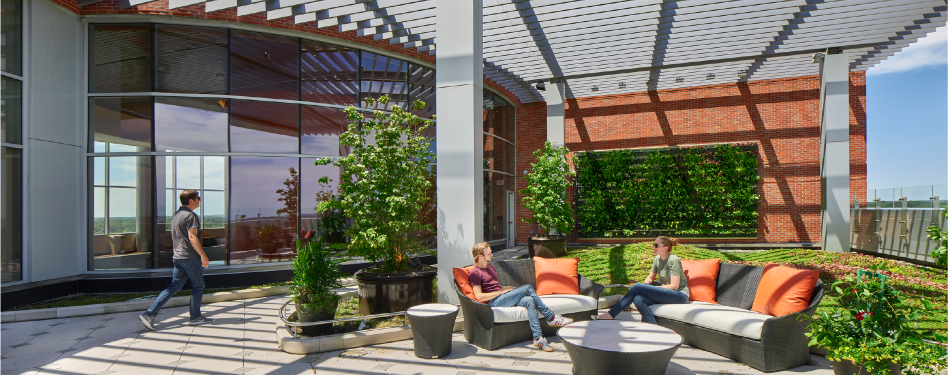
Feature image: EYP project in Hackensack, New Jersey. Photo credit: Halkin Mason Photography.
In December 2021, leading architecture and engineering firm EYP announced the launch of its sustainable landscape design practice to create healthier and more productive environments. Guided by programs like the Sustainable SITES Initiative, EYP’s landscape approach builds on its history of sustainably focused design.
Jessica A. Petro, PLA, ASLA, SITES AP, is the lead designer and landscape architect spearheading the firm’s focus on creating high-performance landscapes.
“Including a sustainable landscape design discipline into EYP’s services allows us to incorporate our sustainable practice from the ground up, leading to healthier, more productive environments for clients, our communities and the site itself,” Petro explains. “Being in-house allows us to be ‘at the table’ during initial decisions. SITES’ prerequisite of having an integrated team approach is vital, enabling designers to influence key decisions early in the design process that can continue to inform sustainable decisions throughout the project. A diverse perspective, influenced by many, provides a richer outcome where humans and nature can flourish.”
Petro looks for opportunities to incorporate the SITES framework into each project. She achieved her SITES Accredited Professional, or SITES AP credential, to provide expertise on client projects, aid in the project’s certification, and leverage the knowledge and resources that GBCI and USGBC offer for continual learning and best practices.
"I appreciate that SITES is performance-based and not prescriptive, which enables the design team to make informed decisions and leverage innovative solutions,” notes Petro. “SITES serves as an incredible resource throughout the project.”

Left: EYP project in Orlando, Florida; right: EYP project in Stamford, Connecticut. Photo credits: Jonathan Hillyer and ESTO/Anton Grassl.
Current climate discussions and the focus on inclusive exterior spaces are expanding the role and exposure of landscape architecture. Petro has observed shifting perspectives on the importance of what a site provides, and in turn, the site’s needs as a functioning natural environment. Landscapes are no longer thought of in purely aesthetic terms, but also as resilient designs that influence and inform the built environment.
EYP’s decision to add a sustainable landscape architecture design practice to its existing business reflects this changing perspective, intentionally aligning the built and natural environments so systems can inform and respond to each other to address client needs within the same organization.
“As public awareness grows and nature continually reminds us, now is the time to join collectively with all stakeholders and users to design and implement sustainable solutions,” says Petro. “As a landscape architect, I feel lucky to be able to create spaces that aid in improving human health and well-being, that are accessible and inclusive for all people, and that allow users to connect with nature while still protecting and enhancing natural systems.”
